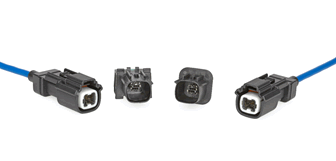Connectivity Solutions for Commercial V2V Communications
Vehicles talk to each other to improve efficiency and safety.

The Sealed HSAutoLink Interconnect System from Molex accommodates connections such as Ethernet, low-voltage differential signaling (LVDS), and more.
It’s now possible for vehicles to communicate with each other – and not by drivers rolling down their windows to shout at each other. Vehicle-to-vehicle (V2V) communications systems can improve the safety, efficiency, and productivity of a wide range of commercial vehicles.
Multiple Systems
Using wireless networks, commercial trucks and buses, agricultural vehicles, and construction and mining vehicles can communicate via in-vehicle devices that continuously share safety, mobility, and environmental information. These connected vehicles can alert drivers to potential hazards, take over vehicle operations when needed, or even manage networks of autonomous vehicles.
A wide range of V2V communications systems are in use or in development. For example, commercial truck applications include forward-collision warning, automatic braking, and blind-spot and lane-change warning. Some construction and mining vehicles have guidance systems that monitor the operating area to avoid hazards, as well as camera-based peripheral vision support systems. Autonomous haulage systems are being developed for driverless truck operations, such as dump trucks.
Agricultural vehicles have, perhaps, the most widely developed portfolio of V2V applications, including vehicle synchronization systems that share data on guidance lines, crop yield, and soil moisture. These systems coordinate tractor and combine operations to control grain flow and maximize loads. Also, GPS mapping systems enable driverless tractor systems monitored remotely or by a lead vehicle.
Another growing commercial vehicle application is driver monitoring systems (DMS), which keep tabs on driver behavior. These systems can ensure that drivers are alert, not texting, and observing speed limits and other parameters. If they sense the driver is not monitoring the current situation, the systems can take over vehicle operation.
V2V communication also enables remote predictive maintenance. Using these systems, vehicles transmit data on operating hours and maintenance intervals to a central processor, which sends out operator alerts when specific maintenance items are required. In the construction and mining industries, many vehicles are leased, and the leasing company must ensure its vehicles are properly maintained. Some remote reporting systems can shut down a vehicle if maintenance is not performed.
System Components
With more data flowing through commercial vehicles, communications systems require high-speed connectors and cables that can transmit 5 – 10Gb/s of data in order to transfer images and video. While some of these connectors handle data only, the trend is to use hybrid connectors that can handle both data and power, some of which can be specified with two or four lines of signal and power.
One major challenge with hybrid connectors is the EMI generated when power is transmitted through the connectors. As a result, connectors and cables in these systems must be insulated to protect against EMI and crosstalk.
Also, commercial vehicle V2V communications systems must be ruggedized, particularly in terms of latching and sealing. They must provide the benefits of high-speed automotive vehicle networks as well as additional protection from vibration, shock, and fluid ingress, while being contained in more complex and denser packages. For that reason, interconnect systems for commercial vehicles require fully protected perimeter seals and wire seals rated to IP67 and IP69K for use in off-road environments.
New Requirements
Interconnect systems must also be designed to accommodate differential-pair electronics. For example, the ruggedized, sealed HSAutoLink Interconnect System from Molex accommodates connections such as Ethernet, low-voltage differential signaling (LVDS), and more.
Today’s interconnect systems are, of course, required to handle higher data speeds and higher-definition video transfer. They must also be capable of rapidly processing new types of sensor data. For example, sensor aggregators or sensor fusion units on commercial vehicles process and interpret data from different types of sensors. In one application, a video camera may capture an image while a light detection and ranging (LIDAR) unit captures the same information by measuring distance after illuminating the target with a laser light. The sensor aggregator confirms the two sensors are “seeing” the same object or event, and allows the V2V communications system to take action. Sensor aggregators can also enable users to time-stamp, record, synchronize, and play back data from various sensors.
Design Best Practices
To accommodate ever-more complex interconnect systems, many commercial vehicle designers are using the zone architecture concept, which breaks electronic systems in the vehicle into separate zones such as front, rear, cabin, drivetrain, infotainment, etc. This allows more efficient data processing within each zone and more effective communications between the different zones.
Designers are also developing different types of Wi-Fi hot spots within vehicles. The first type allows connection with devices within the vehicle, while the second communicates outward, with stationary devices and other vehicles. Standards organizations such as IEEE and SAE are working to develop coherent open standards for these networks.
One of the key questions is which protocol, or protocols, will handle wireless V2V and vehicle-to-object (V2X) communications. One approach is to use dedicated short-range communications (DSRC), a global communications standard that links vehicles with stationary electronic units outside the vehicle to monitor parameters such as traffic flow and weather conditions. It can also be used for V2V communications. For example, if a vehicle is approaching another too quickly or from a blind spot, the vehicles could be directed to take evasive action.
However, rather than creating an expensive secondary network of DSRC devices, some proponents are advocating for a system based on the emerging LTE 5, or 5G, protocol, which will be used to govern cellular phone traffic (to replace the current 4G protocol). Proponents argue that 5G will be fast enough to communicate as effectively as DSRC devices without the added network development costs.
However this debate turns out, there is no question that commercial V2V communications will continue to expand, both in the numbers of vehicles using it and the applications it can support. Connectivity solutions must be capable of handling higher data speeds and power demands in order to support this dynamic new world of communications.
Author Mike Gardner develops in-vehicle network interconnect systems for automotive and industrial solutions at Molex.
In-depth research reports from Bishop & Associates covering the automotive connector market include:
World Automotive Connector Market
Non-Automotive Transportation Market for Connectors




